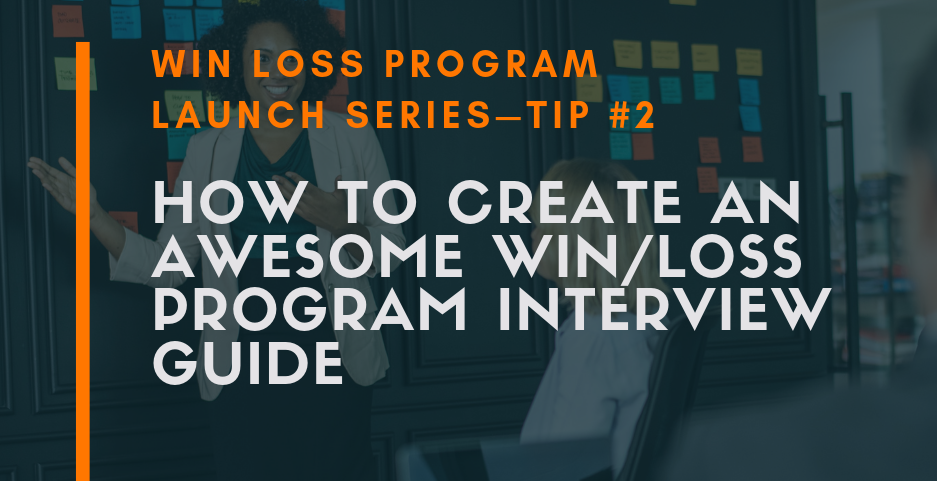(This article is written for those organizations that wish to move from Stage 2 to Stage 3 of the Win/Loss Program Maturity Model. See "Win/Loss Program Maturity Model: How to Map the Maturity of Your Win/Loss Program and Drive Actionable Results").
Now that you’ve built your committee of key stakeholders, your program manager should work with those stakeholders to create a set of specific questions that will be asked during your win/loss interviews, or what DoubleCheck calls an interview guide. Consider this guide a roadmap to the interview itself. This question-writing process is vital, since interview standardization helps you to easily compare data over time and draw out trends. Here, we look step by step at how to create a successful interview guide.
Step 1: Preparation and Development of Win/Loss Program Interview Questions
Before the key stakeholder groups start to build their questions, ensure that they’ve established their key areas of focus and are clear on the data they want to collect via the interview process and why. They should be able to pinpoint:
- The key problems they wish to solve.
- What is important for them to uncover.
- How they will use the data gathered during the interview.
This information will help to shape the questions they build.
In order to let the respondent be the expert on their own experiences, the committee should generally create open-ended questions. Closed questions create a limited focus, which can often result in too narrow an answer. That said, the stakeholder groups should trust the interviewers to probe more deeply as required and to use closed questions for clarification, should the need arise.
Step 2: Win/Loss Program Questionnaire Review and Approval
Once they’ve built their questions, give each stakeholder group time to review and approve the questions created. The more specialist eyes you have on each question, the more you’ll be able to focus and standardize. Expect each set of questions to have a markedly different focus, depending on the department that generates them.
As a rule of thumb, here are the kinds of questions you can expect, by department:
👩⚖️ Product Marketing—
Key areas include reputation before and after the process, key influencers, and analyst/consultant impact:
- What was your perception of us coming into the evaluation?
- Where do you go for advice, knowledge, and/or inspiration?
- Which of our materials was most/least helpful?
💡 Product Management—
Key areas include impact of the solution, information about product gaps, and opportunities for further development:
- What are our greatest solution benefits?
- What are our biggest gaps?
- Are we behind or ahead of the competition?
👁️ Competitive Intelligence—
Key areas include asking how competitors and their sales teams are positioned against your company, and how you are positioned against them:
- Who else did you evaluate?
- What were the strengths and weaknesses of each?
- What was the one thing that tipped the scale?
🏁 Sales Enablement—
Key areas include your sales team’s responsiveness, and their ability to align the customer’s needs and vision to the solution:
- How was your overall sales experience?
- What could have been done better?
- How did our sales team differ from the competition?
Once the stakeholder committee and project manager have reviewed and approved the questions, you can put together the interview guide in full.
Step 3: Using Your Win/Loss Program Interview Guide
Before your interviewers start using the guide, it is important that they understand how to conduct the process. Though it is important that they follow the script, rigidity is a mistake. Interviewers should feel able to probe deeper or to clarify, asking second- or third-level questions to extract a fuller understanding, when necessary. Tangents, however, should be avoided, else the balance will be lost. To ensure a sharp focus, you may wish to establish timings for the interview, which can be gauged by running rehearsals with the guide.
Getting the Most Out of Your Win/Loss Program Interview Guide
Your interview guide is now ready to use, and it’s time to make the most of out of it. Your guide can also be used to create an online survey that is triggered every time a win or loss appears in the CRM system. This survey, which can be filled out by the interviewee prior to the interview itself, can ask similar questions to those in the guide, but at a more tactical level. A skilled interviewer can take this extra data and use it to inform their second- and third-level questions, thus adding an edge.
Now that you’ve carefully standardized the questions in your interview guide and, if elected, used them to generate an online survey, you can more confidently rely on the data you collect. You’ve paved the way for a clearer understanding of customer needs and expectations, and can leverage the data over time to spot trends and locate problems.
In the next article, we’ll examine how to build your technology stack to effectively support your win/loss program.
Just getting started with your win/loss program? Check out these articles:
- How to Launch a Successful Win/Loss Program: Tip 1—First Gain Stakeholder Buy-In
- Win/Loss Program Maturity Model: How to Map the Maturity of Your Win/Loss Program and Drive Actionable Results
- Why Win Interviews Are as Crucial as Loss Interviews for Future Success
Want to learn more about win/loss analysis? Check out some of our other awesome content.
Become a DoubleCheck Insider!


